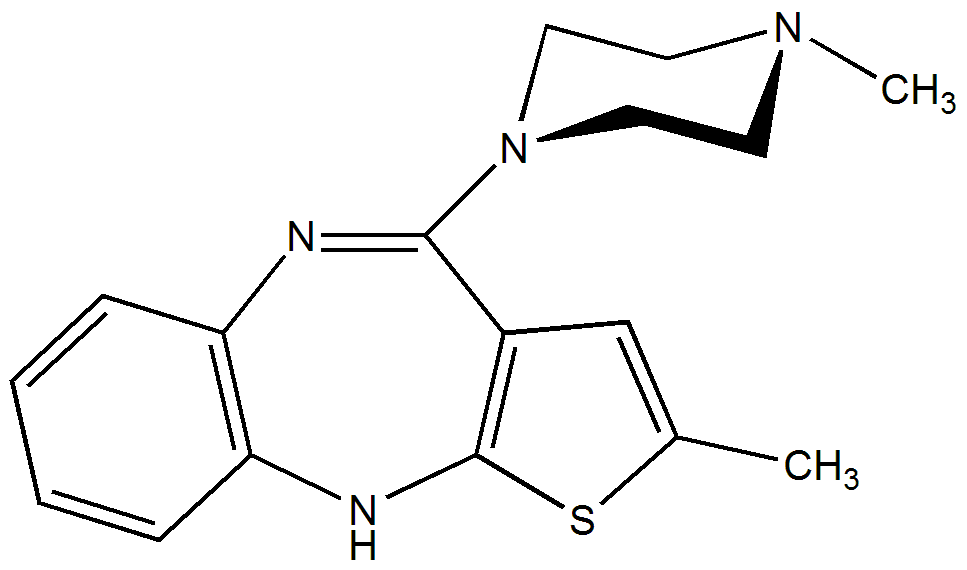This is an old revision of this page, as edited by Gadfium (talk | contribs) at 23:34, 22 November 2004 (Fix link). The present address (URL) is a permanent link to this revision, which may differ significantly from the current revision.
Revision as of 23:34, 22 November 2004 by Gadfium (talk | contribs) (Fix link)(diff) ← Previous revision | Latest revision (diff) | Newer revision → (diff)Olanzapine (Zyprexa® or in a combination with fluoxetine as Symbyax®) was the second atypical antipsychotic to gain FDA approval and has become one of the most commonly used atypical antipsychotics. Olanzapine has been FDA approved for the treatment of schizophrenia, acute mania in bipolar disorder, agitation associated with schizophrenia and bipolar disorder, and as maintenance treatment in bipolar disorder. Olanzapine is manufactured and marketed by the pharmaceutical company Eli Lilly and Company.
Pharmacology
Olanzapine is structurally similar to clozapine, and is classified as a thienobenzodiazepine. Olanzapine has a high affinity for dopamine, serotonin, histamine, cholinergic muscarinic and alpha adrenergic receptors. The mechanism of action of olanzapine is unknown, however it is theorized that olanzapine's antipsychotic activity is mediated primarily by antagonism at dopamine receptors, specifically D2. Serotonin antagonism may also play a role in the effectiveness of olanzapine, but the significance of 5-HT2A antagonism is debated among researchers. Antagonism at muscarinic, histaminic and alpha adrenergic receptors likely explains some of the side effects of olanzapine, such as anticholinergic effects, sedation and orthostasis.
Pharmacokinetics
Olanzapine displays linear kinetics. Its elimination half-life ranges from 21 to 54 hours. Steady state plasma concentrations are achieved in about a week. Olanzapine undergoes extensive first pass metabolism and bioavailability is not effected by food.
Metabolism
Olanzapine is metabolize by the Cytochrome P450 system isoenzymes 1A2 and 2D6 (minor pathway). Drug metabolism may be increased or decreased by agents that induce (e.g. cigarette smoke) or inhibit (e.g. fluvoxamine or ciprofloxacin) CYP1A2 activity respectively.
Chemistry
Olanzapine is 2-methyl-4-(4-methyl-1-piperazinyl)-10H-thienobenzodiazepine, C17H20N4S.
Adverse Events
Adverse events reported in the package insert for olanzapine include dry mouth, dizziness, sedation, insomnia, orthostasis, akathisia, and weight gain. Olanzapine is reported to cause extrapyramidal symptoms, tardive dyskinesia and neurological malignant syndrome, although at a much reduced rate when compared to the classical antipsychotics.
Recently the FDA required the manufacturers of all atypical antipsychotics to include a warning about the risk of hyperglycemia and diabetes with atypical antipsychotics. Indeed, there are many case reports of olanzapine-induced hyperglycemia and diabetes. Additionally there are some case reports of olanzapine-induced diabetic ketoacidosis. There is data showing that olanzapine can decrease insulin sensitivity. In addition, increased triglyceride level may also be an issue with olanzapine. Impaired glucose metabolism, high triglycerides, and obesity have been shown to be constituents of the metabolic syndrome and may increase the risk of cardiovascular disease. The data suggests that olanzapine may be more likely to cause adverse metabolic effects than some of the other atypical antipsychotics.
In 2004, the Committee for the Safety of Medicines (CSM) in the UK issued a warning that olanzapine and another atypical antipsychotic, risperidone should not be given to elderly patients with dementia, because of an increased risk of stroke.
External links
- Zyprexa - manufacturer's site
- Olanzapine.com - promotional site
- Package Insert (PDF)
